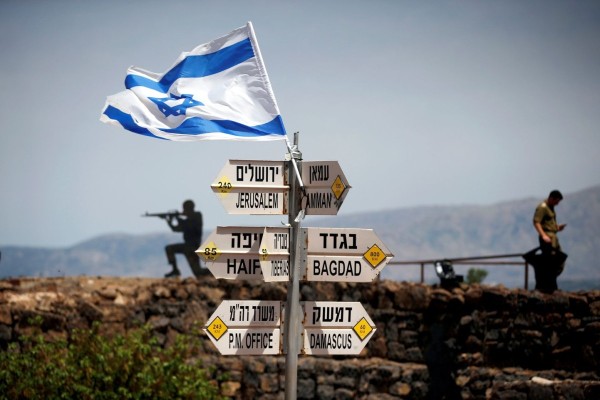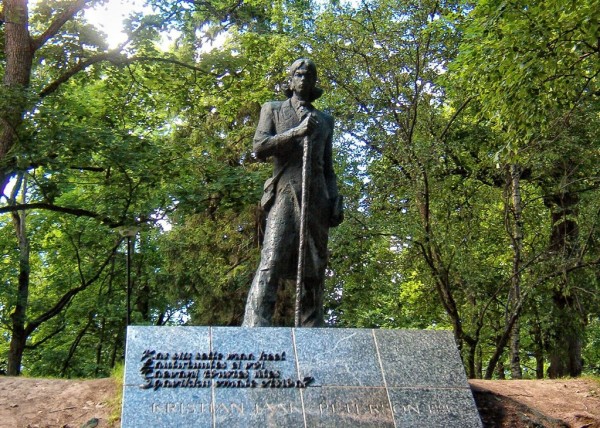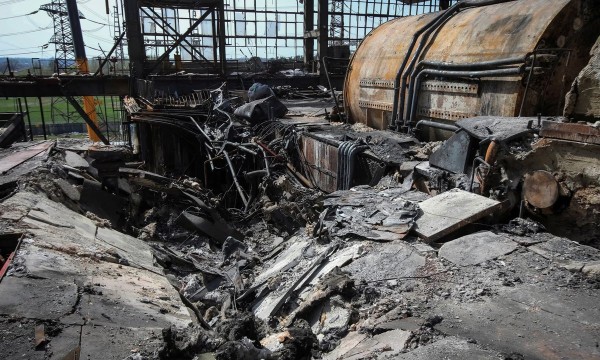(Three Bird Droppings arrived at once, EWR is posting them month by month. ed)
I caught the last of summer this month at Viru Folk Festival in Käsmu where the sun shone on three days of song and poetry. This year’s theme was the culture of the Sami peoples, culturally related to us but who live in the far north of Scandinavia and Russia.
There was music from all over the world. I especially liked the Russian girl band Iva Nova (the New Eve) who started their programme by yelling “its great to be in a free country.” There was an interesting talk about Sami drums and, afterwards, I was able to be useful and advise the Norwegian professor to seek out Lennart Meri’s fascinating records of Finno-Ugric cultures.
Then, back home on a history tour, starting at Ilumäe in Vihula parish, Lääne Virumaa. Ilumäe is in the back of beyond on the road from Palmse to Vatku in a clearing in the forests of Virumaa County. There is nothing there except a small white chapel, a graveyard and a memorial. A wooden chapel was built here in 1729 by the local baron. A hundred years later the baron (still a von Pahlen) and the peasants replaced it with a stone chapel in 1841-43.
Ilumäe was a sacred place a long time before Christianity arrived and even after the chapel was built the dead were still taken to their graves via the spruce grove of the dead (Surnukuuskede) near the Ilumäe sacred lime tree (Hiieniinepuu). The Hiieniinepuu is 300 - 452 years old and one of the old sacred places of the Estonians. Our ancient groves are unique in Europe – nowhere are these places and their customs so well preserved. The Hiieniinepuu is still strong and leafy with ribbons tied to her branches by newlyweds and others seeking good fortune. A helpful information board (in Estonian and English) explains that a ribbon is not just an offering; it forges a link between you, the sacred place and your ancestors. Hmm. I must return with a smart piece of ribbon. I didn’t think the ancestors would appreciate the bits of frayed old string laying around in the travelling garbage tip that is my car. One doesn’t like to seem disrespectful. The information board was very plain about what was expected. “Ancient wisdom knows that one must not break off even a little branch from a grove … Be quiet, dress neatly, be sober …it is not allowed to shit or urinate here.” Quite.
The Hiieniinepuu was a place of prayer, celebration, oath-taking and healing. There was once a Silmaallikas (Eye stream) nearby where bread was dipped in the water and applied to sick eyes. What a pity it’s dried up - with the price of glasses these days, anything is worth a try. It was customary to bring offerings to the Hiieniinepuu – the first harvest grain, the first slice of meat from a slaughtered animal, dairy products, beer, honey, coins. The weather-beaten doll tied to a branch was a reminder that the tree was once used as a shelter for child shepherds during bad weather.
Many folk tales exist about the tree. They were very possibly collected by our Vidri Rein Ristmets (Friedrich Kreutzwald, author of Kalevipoeg, the national epic) from the neighbouring Kadrina region when he was rummaging around smoky barns and stepping in cow pats seeking out our ancient oral heritage. We know that Vidri Rein knew about the Pahlen barons - there are stories about them in his Old Estonian folk tales, Eestirahwa Ennemuistsed jutud (1866). The tales (and there is even one – The building of the chapel, Kabeli ehitamine – about the Ilumäe chapel) portray the Pahlens as peasant-friendly and Ilumäe suggests that this is true.
The chapel contains eight stained glass panels (copies- the originals are in Rakvere Museum) with coats of arms dated 1729. Six of them are not noble heraldry but seem to be the arms of tradesmen. Under the shields there are pictures of a (?) giant beet (for Evalt Muick), ploughing (for Jacob Muick), windmills (for Diedrich Muick), a water wheel (for Arend Porggast and his wife Mall) and compasses, protractors and squares for Marten Sae, Jacob Falck, Jürgen Lawick (were they carpenters or masons?). A public display of the arms of millers and masons (says Indrek Rohtmets in A cultural guide to Estonia, Kultuurilooline Eestimaa) would have been impossible without permission from the manor … The 1729 date is just ten years before the Rosen Declaration that many regard as the nadir of Estonian history. This nasty document (for those now scrabbling around for their Eesti Encyclopedia) led to the official recognition by Russia of serfdom in Estonian lands and the total subjugation of the Estonians to the Baltic German barons. Estonians did not even own their pots and pans and the barons were free to whip us as much as they liked (a lot) and to split up families. Stories of a father of several children being swapped for a hunting hound and never seeing his family again are legion.
The von Pahlens were not buried beside their peasants. They were not that egalitarian. They rest in a separate enclosure (behind an iron fence) at Ilumäe. The last gravestone is that of Elisabeth, Marquise des Aubris de Vatan (1914–2008) who was born at Palmse and died in Munich. My grandfather and aunt lie among the common folk amongst the trees (as is usual in Estonian cemeteries). Other Meikars and Männiks (the names of my grandparents) are listed among 149 men remembered on 15 tablets, their names written in gold on black stone, in a fine memorial in front of the Ilumäe chapel gate.
None of the people named on the Ilumäe Memorial have known graves. Forty fell (Maalmasõjas langenud) in the first World War; nine were seized in Palmse and murdered in Jõhvi in 1918 during a Communist invasion of newly independent Republican Estonia (1918 –20); 21 fell in the Second World War (1941-45 langenud); ten were killed in Estonia 1941-1951 (1941 –45 Eestis during the Soviet and Nazi occupations; 20 died in Siberia (1941-1945 hukkunud) and 49 were deported during 1941 –1949 (1941-1949 küüditatud).
In this year of the centenary of WWI spare a thought and light a candle for Elmar, Julius, Richard and Jakob and their friends born in the 1890s who marched off (as my Czech friend once remarked laconically “in other people’s uniforms”) in 1914 over the hills and far away and never came back. One hundred years later the tragedies of war are still going on in Syria, Israel, the Ukraine and elsewhere. Really, you would think that the human race, having gone to the moon and discovered DNA (the very stuff of life) would have moved on a bit … I grow melancholic and autumnal …
Bird Droppings from Estonia: September’s history tour (1)
Viimased kommentaarid
Kommentaarid on kirjutatud EWR lugejate poolt. Nende sisu ei pruugi ühtida EWR toimetuse seisukohtadega.
Nice to hear from you again, Birdie dear! It's been a while.
That you can trace your roots to Käsmu makes me envious. That has to be one of the most charming villages in Estonia.
My roots are in Tartumaa, at the end of a gravel road with a farm on either side. Mysteriously, the place has a name and a spot on the map.
That you can trace your roots to Käsmu makes me envious. That has to be one of the most charming villages in Estonia.
My roots are in Tartumaa, at the end of a gravel road with a farm on either side. Mysteriously, the place has a name and a spot on the map.
Arvamus
TRENDING


























